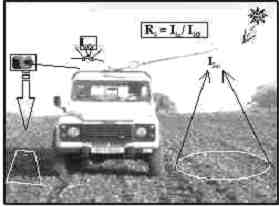
Saturday, 15 July 2006
131-2
Precise Maps of Organic Matter and Topsoil Features by a Proximal Sensing Hyperspectral Scanner and a Digital Carnera.
Goetz Reimer and Juergen Lamp. C.A.Univ, Plant Nutrition a. Soil Science, WG Soil Informatics, Olshausenstr. 40, Kiel, D24118, Germany
1. Problem. The organic matter content in Ap horizons (OM) is an important indicator of landform and soil formation, and a parameter for several application algorithms in Precision Farming (PF). Because conventional analyses of OM from bulked topsoil samples are expensive and may not describe complex OM patterns within fields, we studied in the joint PF research project preagro to sense and map OM of fields by a hyperspectral Zeiss spectrometer (www.tec5.de). Since the spectrometer was scheduled to work on-the-go on a terrain vehicle, emphasis was laid on disturbing topsoil features which may hamper the proximal OM sensing. 2. Sites, techniques and methods. Study fields were selected from preagro fields in Germany (poster Herbst&Lamp) where the OM often varied from 1-10% in sloping soilscapes from different origin (e.g. young glacial till and sand/loess-covered limestone). The spectral scanner works (a) under laboratory conditions for prepared soil samples and (b) in the field on top of the "SoilRover" for sensing not-conditioned surface cells serially along tramlines. Spectral references are a white standard (ceramic plate) for (a), and the sky light meas-ured by a second channel for (b). The spectral responses are evaluated as remission (%Rl) for each of 256 spectral bands within the wavelength (l) range 400-1100 nm . Due to exponential relations between OM and %Rl, logarithms are used for regression analyses. A digital camera (Kodak DC 290) takes on-the-go pictures, semi-automatically. Images are stored in a database and evaluated visually for coverages of crops, residuals, stones etc. 3. Results. Laboratory analyses: Depending upon region and field variability, OM can be predicted with 2–30% unexplained variance, only. Regression coefficients point to different humus qualities. On-the-go field sensing: Under favorable conditions, e.g. seed bed after sugar beets and uniform-moist surfaces, a multiple estimation of OM resulted in r² of 93%, but unfavorable, non-uniform surface conditions on fields dropped r² down to 50%. Visual image interpretation of the local coverages of crop stands, residues, stones and structure type can help to map and eliminate these disturbance factors.

Back to 1.5A Diffuse Reflectance Spectroscopy, Soil Sensing, Remote Sensing and Image Analysis - Poster
Back to WCSS
Back to The 18th World Congress of Soil Science (July 9-15, 2006)